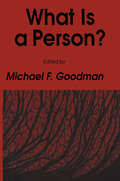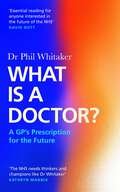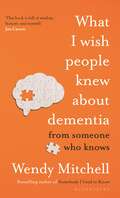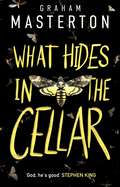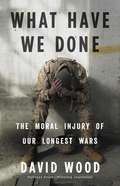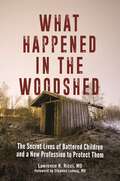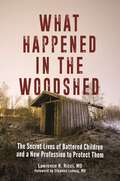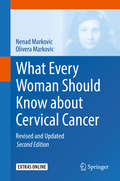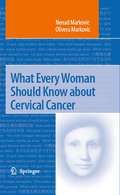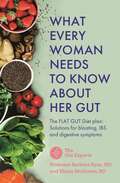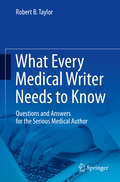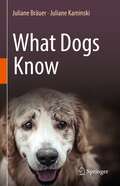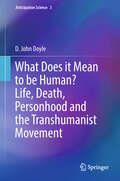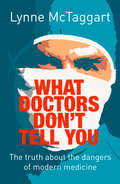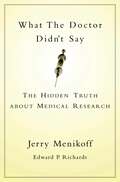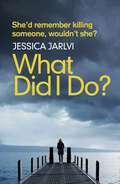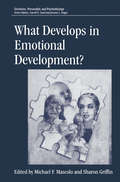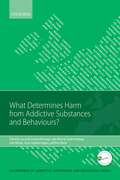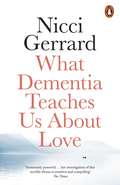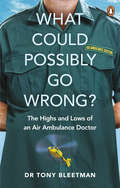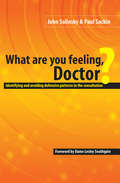- Table View
- List View
What Is a Person? (Contemporary Issues in Biomedicine, Ethics, and Society)
by Michael F. GoodmanThe idea for an anthology on personhood grew out of two things, viz. , the work I did with Martin Benjamin during the Summer of 1982 at Michigan State University on the question, What is a person?, and the amount of time, effort, and expense required for serious research on the topic itself. The former experience taught me the importance of, among other things, attempting to get clear about what we are to mean by 'person,' while the latter experience suggested a possible course of action whereby getting clear might be made more manage able simply by having relatively convenient access to some of the most insightful and stimulating writings on the topic. The problems of personhood addressed in this book are central to issues in ethics ranging from the treatment or termination of infants with birth defects to the question whether there can be rational suicide. But before questions on such issues as the morality of abortion, genetic engineering, infanticide, and so on, can be settled, the prob lems of personhood must be clarified and analyzed. Hence What Is a Person? has as its primary theme the examination of various proposed conditions of personhood.
What Is a Doctor?: A GP's Prescription for the Future
by Dr Phil WhitakerA WATERSTONES BEST BOOK OF 2023: POPULAR SCIENCE What Is a Doctor? is a vital contribution to the ongoing debate about how we maintain an NHS that is both fit for purpose and free. Using stories and case studies from across his thirty-year career as a GP, Dr Phil Whitaker offers insight into the medical movements, political interference and societal changes that have transformed the role of doctor over the past three decades. Much has altered for the better but, even when based on good intentions, an equal or greater amount has been damaging and threatens the sustainability of the NHS. In examining what it means to be a doctor today, this book also answers an accompanying question ‘what is a patient?’ – and how we can all take a more active role in our healthcare. And, looking forward, Dr Whitaker describes what might yet be done to restore the NHS and its capacity for properly patient-centred care.
What I Wish People Knew About Dementia: The Sunday Times Bestseller
by Wendy MitchellTHE SUNDAY TIMES BESTSELLER'Essential reading' SUNDAY TIMES MAGAZINE'A book of hope' OBSERVER'A marvellous tour of insights' THE TIMES'A must-read . . . I couldn't recommend it higher' MICHAEL BALL'Wendy Mitchell is a life-saver' FRANCES WILSON, AUTHOR OF BURNING MANWhat can a diseased brain tell us about being human, living our own lives better and helping those with dementia get the best from theirs?When Wendy Mitchell was diagnosed with young-onset dementia at the age of fifty-eight, her brain was overwhelmed with images of the last stages of the disease - those familiar tropes, shortcuts and clichés that we are fed by the media, or even our own health professionals. But her diagnosis far from represented the end of her life. Instead, it was the start of a very different one. Wise, practical and life affirming, What I Wish People Knew About Dementia combines anecdotes, research and Wendy Mitchell's own brilliant wit and wisdom to tell readers exactly what she wishes they knew about dementia.
What I Say: Conversations That Improve the Physician-Patient Relationship
by Jack Parker Robert OsherPhysicians of all disciplines know (or quickly learn the hard way) that effective and compassionate communication is arguably the single most important determinant of patient satisfaction. For cataract surgeons, the words said before, after, and even during the operation are often more important to the patient’s happiness than the objective quality of the surgical result.What I Say: Conversations that Improve the Physician-Patient Relationship is designed to help cataract surgeons to hone their verbal interactions to be as sharp as their surgical skills. Muddled, clumsy, or impromptu explanations diminish the doctor-patient relationship and could prevent patients from receiving the surgery they need or appreciating the results they get. Knowing in advance which words to use in difficult situations is analogous to knowing how to manage a complication before it occurs. The results are inevitably better when a physician has considered every possible outcome instead of attempting to come up with exactly the right solution on the spot. Rather than figure out the right words by trial and error, however, What I Say has recommendations on exactly what to say to build strong and trusting patient relationships. Drs. Robert Osher and Jack Parker have compiled conversational scripts from Dr. Osher’s 40-year career in ophthalmology, as well as contributions from over a dozen international mavens of bedside manner into a strategy guide through even the most difficult patient conversations that inevitably surround cataract surgery.Topics include: Lowering Expectations for Spectacle-Free Vision The Torn Posterior Capsule Postoperative Refractive Surprise The Dropped Nucleus The Unhappy Patient Despite a Good Result Containing examples of conversations with cataract surgery patients where informing and reassuring take top priority, What I Say: Conversations that Improve the Physician-Patient Relationship was created to aid cataract surgeons in their pre-operative, intra-operative, and post-operative interactions with patients. With the advice contained inside, surgeons will be able to motivate patients, calibrate expectations, and diffuse frustrations in every possible scenario.
What I Say: Conversations That Improve the Physician-Patient Relationship
by Jack Parker Robert OsherPhysicians of all disciplines know (or quickly learn the hard way) that effective and compassionate communication is arguably the single most important determinant of patient satisfaction. For cataract surgeons, the words said before, after, and even during the operation are often more important to the patient’s happiness than the objective quality of the surgical result.What I Say: Conversations that Improve the Physician-Patient Relationship is designed to help cataract surgeons to hone their verbal interactions to be as sharp as their surgical skills. Muddled, clumsy, or impromptu explanations diminish the doctor-patient relationship and could prevent patients from receiving the surgery they need or appreciating the results they get. Knowing in advance which words to use in difficult situations is analogous to knowing how to manage a complication before it occurs. The results are inevitably better when a physician has considered every possible outcome instead of attempting to come up with exactly the right solution on the spot. Rather than figure out the right words by trial and error, however, What I Say has recommendations on exactly what to say to build strong and trusting patient relationships. Drs. Robert Osher and Jack Parker have compiled conversational scripts from Dr. Osher’s 40-year career in ophthalmology, as well as contributions from over a dozen international mavens of bedside manner into a strategy guide through even the most difficult patient conversations that inevitably surround cataract surgery.Topics include: Lowering Expectations for Spectacle-Free Vision The Torn Posterior Capsule Postoperative Refractive Surprise The Dropped Nucleus The Unhappy Patient Despite a Good Result Containing examples of conversations with cataract surgery patients where informing and reassuring take top priority, What I Say: Conversations that Improve the Physician-Patient Relationship was created to aid cataract surgeons in their pre-operative, intra-operative, and post-operative interactions with patients. With the advice contained inside, surgeons will be able to motivate patients, calibrate expectations, and diffuse frustrations in every possible scenario.
What Hides in the Cellar: A disturbing paranormal thriller to keep you up this Halloween (Patel & Pardoe #4)
by Graham Masterton'God, he's good.' Stephen KingA SEVERED HEADA grisly series of murders across London is baffling local authorities. Eyewitnesses describe suspects who are only partially visible – one appears to have no feet, another no head, a fourth is missing his entire right side.A SUPERNATURAL CASEThese murders are neither straightforward nor easily explained, which means there are only two people fit to investigate: DS Jamila Patel and DC Jerry Pardoe, who are used to tracking spirits intent on causing mayhem.A BLOODY HISTORYWhen two children go missing – finding themselves lost in another time period altogether – the investigation leads to the discovery of a violent entity. One who has been killing for much longer than anyone first realised – and has no plans to stop...The new PATEL and PARDOE mystery.For fans of Joe Hill, Peter James and Stephen King, Graham Masterton is a master of the horror genre whose books have sold millions of copies across the globe.Praise for Graham Masterton:'One of the most original and frightening storytellers of our time' Peter James'Suspenseful and tension-filled... all the finesse of a master storyteller' Guardian'One of Britain's finest horror writers' Daily Mail
What Have We Done: The Moral Injury of Our Longest Wars
by David WoodFrom Pulitzer Prize-¬?winning journalist David Wood, a battlefield view of moral injury, the signature wound of America's 21st century wars. Most Americans are now familiar with Post Traumatic Stress Disorder (PTSD) and its prevalence among troops. In this groundbreaking new book, David Wood examines the far more pervasive yet less understood experience of those we send to war: moral injury, the violation of our fundamental values of right and wrong that so often occurs in the impossible moral dilemmas of modern conflict. Featuring portraits of combat veterans and leading mental health researchers, along with Wood's personal observations of war and the young Americans deployed in Iraq and Afghanistan, What Have We Done offers an unflinching look at war and those who volunteer for it: the thrill and pride of service and, too often, the scars of moral injury. Impeccably researched and deeply personal, What Have We Done is a compassionate, finely drawn study of modern war and those caught up in it. It is a call to acknowledge our newest generation of veterans by listening intently to them and absorbing their stories; and, as new wars approach, to ponder the inevitable human costs of putting American "boots on the ground."
What Happened in the Woodshed: The Secret Lives of Battered Children and a New Profession to Protect Them
by Lawrence R. M.D.A riveting exposé of child abuse in America and how the newest breed of pediatricians determines what happened, why, and at whose hands.Although more than one million children are abused each year in the United States, child abuse often remains a secret to family members, professionals, and politicians who neither see nor understand it. Child abuse pediatricians are the newest breed of pediatricians, specialized in exposing abuse. With detective-like acumen, child abuse pediatricians deduce through careful medical analysis who has abused and who has been abused. Describing the most compelling cases among the thousands that they have evaluated, author Lawrence Ricci reveals the trauma, pain, disability, and sometimes death that abused children experience at the hands of trusted adults.This gripping look at the dark side of American families is about good parents and poor ones, perpetrators and victims, and collateral victims such as innocent family members. It is also about the professionals who have made it their career to expose child abuse and to treat children who have suffered from it. The conclusion calls for systematic changes that could help to stem the tide of child abuse.
What Happened in the Woodshed: The Secret Lives of Battered Children and a New Profession to Protect Them
by Lawrence R. M.D.A riveting exposé of child abuse in America and how the newest breed of pediatricians determines what happened, why, and at whose hands.Although more than one million children are abused each year in the United States, child abuse often remains a secret to family members, professionals, and politicians who neither see nor understand it. Child abuse pediatricians are the newest breed of pediatricians, specialized in exposing abuse. With detective-like acumen, child abuse pediatricians deduce through careful medical analysis who has abused and who has been abused. Describing the most compelling cases among the thousands that they have evaluated, author Lawrence Ricci reveals the trauma, pain, disability, and sometimes death that abused children experience at the hands of trusted adults.This gripping look at the dark side of American families is about good parents and poor ones, perpetrators and victims, and collateral victims such as innocent family members. It is also about the professionals who have made it their career to expose child abuse and to treat children who have suffered from it. The conclusion calls for systematic changes that could help to stem the tide of child abuse.
What Every Woman Should Know about Cervical Cancer: Revised and Updated
by Nenad Markovic Olivera MarkovicThis book (an updated and extended edition) is about mobilizing women and health care policy makers and providers to unite their efforts in a single strategy for fighting cervical cancer worldwide. The objective of this strategy would be to reverse cervical cancer prevalence and mortality rates among all 2.4 billion women at risk and to achieve this goal within 10-15 years of implementation. Cervical Cancer Screening (Pap test, VIA, VILI, or HPV) failed to stop cervical cancer worldwide simply because many countries could not afford developing infrastructure necessary to carry on the global strategy, and because the outreach could not accomplish the targeted 51% of the population at risk. In 2015, there is still 600,000 women getting cervical cancer annually and 300,000 of them die. Every minute one woman gets cervical cancer and every 2 minutes one woman dies from this preventable disease. In 21st Century the Information Technology (IT) Revolution has made substantial impact on medicine enabling remote points-of care, scattered around the world, to be e-connected with experts in distant medical centers and to obtain quality diagnosis and proper guidelines for curative therapy of early stages of cervical cancer. Low frequency of costly interventions needed makes IT-based screening financially and socially beneficial for mass screening. This new Mobile Health technology with the Global Strategy for Fighting Cervical Cancer is subject to elaboration in our book as the new hope when old efforts have failed to stop the world “epidemics” of this grave but preventable disease. The language is adapted for easy reading and understanding by professionals and lay-persons. This book is intended for women at risk for cervical cancer, their health care providers, health insurance companies, government responsible for making health policy and healthcare industry because all of them have special role in the new Global Strategy elaborated in details in this book.
What Every Woman Should Know about Cervical Cancer
by Nenad Markovic Olivera MarkovicRecent introduction of HPV vaccines has raised hopes for immunization against cervical cancer and for the first time in the history of humanity for eradication of one malignant disease. This new “opportunity” has changed many current views on cervical cancer prevention, control diagnosis and treatment. Many canons and guidelines became subject of review and many revisions are coming. This book is intended to summarize most of these events and to present them to all women in a language understandable by the eneral public. We expect the book will bring all readers the rationale for optimism and will provide guidance as how to gain knowledge and skills for critical thinking and making an educated decision when it will be necessary in their lives.
What Every Woman Needs to Know About Her Skin and Hair: How the hormones on your inside affect you on the outside
by Dr Mandy LeonhardtThe appearance of our skin and hair has a huge impact on our psychological wellbeing and confidence. Women feel pressure to have glowing, blemish-free skin, and thick, luscious hair at all times - in reality, our skin is a dynamic living organ which reacts to hormonal changes across the lifecycle, from puberty to the menopause. When our skin does not look healthy, and when our hair is thin or falling out, we want to understand why, and what we can do about it. We can spend large amounts on different creams and beauty products, or cover the problem with makeup, but ultimately the question most asked by women, and unanswered by skincare regimes, is 'could this be hormonal?'The answer is, of course, 'yes' - and if you read this book, you'll know exactly how and why. By giving you a better understanding of the relationship between your hormones, and common skin and hair problems, Dr Mandy Leonhardt will help you find lasting solutions whatever your issue. Whether you suffer with outbreaks, dry skin, sensitive skin, pigmentation or are concerned about the way your skin is aging in midlife, What Every Woman Needs to Know About Her Skin and Hair will provide you with the tools to find more holistic and effective solutions which don't just scratch (or moisturise) the surface, but which look at the root cause of the problem. Drawing on both the latest research and on her years of experience as a GP and specialist in women's health, Dr Leonhardt offers scientifically proven and practical advice to both understand and better manage the condition of your skin, hair and nails. She will explain which skincare principles (and types of product) are worthwhile, and which aren't; and how you can effectively connect the dots between your skin health and factors like nutrition and lifestyle. She gives clear advice on which non-medical treatments are worth pursuing (and, again, which aren't), and plenty of additional resources to help you find a cost-effective regime which takes both your hormonal stage in life and your bank balance into account.
What Every Woman Needs to Know About Her Gut: The FLAT GUT Diet Plan
by Barbara Ryan Elaine McGowan* Digestive problems* Bloating* Diarrhoea* Constipation* PainDo you identify with these symptoms? Does your digestive system feel like your enemy? Is your unpredictable gut a source of embarrassment or fear, or is it holding you back?If you're a woman who's answered 'yes' to any of the above, you're not alone. More than two-thirds of people with IBS are female; other gut problems are also more common in women. And your needs are very specific.YOU NEED: Clear, accessible information about and insight into what female hormones can do to gut healthYOU NEED: Expert guidance from a consultant gastroenterologist and a clinical dietitian and nutritionistYOU NEED: Stepped, manageable strategies to take control of your troublesome gutYOU NEED: A diet plan that focuses on your specific requirements, which is flexible, achieveable and sustainableYOU NEED: Easy-to-follow recipes that are gut-friendly, delicious and restore your digestive healthYOU NEED THIS BOOK!Professor Barbara Ryan and Elaine McGowan, RD, are The Gut Experts (@thegutexperts and www.thegutexperts.com) and have treated over 60,000 patients with every kind of digestive condition and nutritional requirement. They are bringing their expertise and insights to you in this easy-to-digest book.
What Every Medical Writer Needs to Know: Questions and Answers for the Serious Medical Author
by Robert B. TaylorThis book presents must-know facts generally not covered in “How To” books about medical writing. Every medical writer, whether a beginner or veteran, needs answers to questions many might not even know to ask. How does your personality type influence your writing behavior, and what can you do to make writing easier for you? What should you ask before agreeing to co-author an article for publication or write a book chapter? What are some of the current issues regarding copyright and plagiarism that authors may face? What has research discovered about the quotations and references found in journal articles? What do you need to know about open access journals and predatory publishers? Dr. Taylor tells some surprising truths about medical publishing, including possible sources of peer review bias and some alarming influences on what ends up in print. He also relates little-known stories about renowned medical writers such as Sir William Osler, William Carlos Williams and Elisabeth Kübler-Ross and the origins of some of medicine’s classic publications.What Every Medical Writer Needs to Know provides information vital for every health care professional who aspires to write for others to read: academicians and practicing physicians; nurses, nurse practitioners and physician assistants; and professional medical and scientific writers.
What Dogs Know
by Juliane Bräuer Juliane KaminskiMy dog understands me! At least, many dog owners think so. New scientific studies actually show that dogs understand a lot about us humans. For example, they can figure out what humans can and cannot see. Some dogs can even distinguish large numbers of toys by name, like Rico, the internationally famous Border collie.But do dogs also understand our emotions? Can they grasp cause and effect relationships? What fascinates us humans about dogs? Is it only the proverbial ‘puppy dog eyes’ that make dogs look sympathetic? Or is it the fact that these animals have grown very well-attuned to humans and are willing to cooperate with them?In a total of ten chapters, Juliane Bräuer and Juliane Kaminski present the results of the most important scientific studies of the last twenty years on dog cognition.
What Does it Mean to be Human? Life, Death, Personhood and the Transhumanist Movement (Anticipation Science #3)
by D. John DoyleThis book is a critical examination of the philosophical and moral issues in relation to human enhancement and the various related medical developments that are now rapidly moving from the laboratory into the clinical realm. In the book, the author critically examines technologies such as genetic engineering, neural implants, pharmacologic enhancement, and cryonic suspension from transhumanist and bioconservative positions, focusing primarily on moral issues and what it means to be a human in a setting where technological interventions sometimes impact strongly on our humanity. The author also introduces the notion that death is a process rather than an event, as well as identifies philosophical and clinical limitations in the contemporary determination of brain death as a precursor to organ procurement for transplantation. The discussion on what exactly it means to be dead is later applied to explore philosophical and clinical issues germane to the cryonics movement. Written by a physician/ scientist and heavily referenced to the peer-reviewed medical and scientific literature, the book is aimed at advanced students and academics but should be readable by any intelligent reader willing to carry out some side-reading. No prior knowledge of moral philosophy is assumed, as the various key approaches to moral philosophy are outlined early in the book.
What Doctors Don’t Tell You: The Truth About The Dangers Of Modern Medicine (What Doctor's Don't Tell You Ser.)
by Lynne McTaggartThe ebook edition of this highly controversial and campaigning book that reveals the truth about the pills and procedures your doctor prescribes and offers proven alternatives for diagnosing, preventing and treating many illnesses. Includes information on all the most recent health issues – vaccination, HRT, Viagra, IVF and more.
What The Doctor Didn't Say: The Hidden Truth About Medical Research
by Jerry Menikoff Edward P. RichardsWhat Did I Do?: Gripping psychological suspense from the best-selling author of 'When I Wake Up'
by Jessica Jarlvi'Jessica Jarlvi is a hugely talented writer and definitely one to watch' SOPHIE HANNAH. I CAN'T REMEMBER... Kristin is on the run. From her life. From herself. When two murders take place in Chicago, Kristin quickly finds herself a prime suspect. The problem is she can't be sure of what she did or didn't do. DID THEY MAKE ME DO IT? In fear for her life, Kristin flees abroad to start her life over. But it's not that easy to escape the past. And whatever she's done, someone is on her tail, wanting her to pay. The question is: could she be a killer and not even remember? Page-turning, gripping, dark, and utterly addictive, this is one thriller that you won't be able to put down. Perfect for fans of Cara Hunter, Mark Edwards and Caroline England. Praise for What Did I Do: 'This booked kept me up way into the small hours' Elaine Lydon, NetGalley. 'This book was insanely good and I loved it from beginning to end' Simra Sadif, NetGalley. 'It's gripping and gritty, dark and intense' Lucii Grubb, NetGalley.
What Develops in Emotional Development? (Emotions, Personality, and Psychotherapy)
by Michael F. Mascolo Sharon GriffinThe problem of development is central in the study of emotional life for two basic reasons. First, emotional life so clearly changes (dramatically in the early years) with new emotional reactions emerging against the backdrop of an increasing sensitivity to context and with self-regulation of emotion emerging from a striking dependence on regulatory assistance from caregivers. Such changes demand developmental analysis. At the same time, understanding such profound changes will surely inform our understanding of the nature of development more generally. The complexity of emotional change, when grasped, will reveal the elusive nature of development itself. At the outset, we know that development is complex. We must take seriously what is present at any given phase, including the newborn period, because a developmental analysis disallows something emerging from noth ing. Still, it is equally nondevelopmental to posit that new forms of new processes were simply present in their precursors. Rather, development is characterized by transformations in which more complex structures and organization "emerge" from new integration of prior components and new capacities. These new forms and organizations cannot be specified from prior conditions but are due to transactions of the evolving organism with its environment over time. They are not simply in the genome, and they are not simply conditioned by the environment. They are the result of the develop mental process.
What Determines Harm from Addictive Substances and Behaviours? (Governance of Addictive Substances and Behaviours Series)
by Edited by Lucy Gell, Gerhard Bühringer, Jane McLeod, Sarah Forberger, John Holmes, Anne Lingford-Hughes, and Petra MeierThe multifaceted nature of harmful substance use and gambling requires interdisciplinary analysis to assess the underlying causes. What Determines Harm from Addictive Substances and Behaviours? draws together evidence from twelve disciplines including anthropology, genetics, neurobiology, and public policy. Using a developmental approach, the book presents evidence on the factors that influence the development of harmful substance use and gambling. The determinants of harm operate at three levels: molecular, individual, and social. This book brings to light the complex interplay between them and presents the scientific, social, economic, political, and psychological influences of harmful substance use and gambling. These individual determinants are then synthesised into an integrative heuristic model to encourage new ways of thinking. The findings from this analysis are used to elaborate key general implications for health and broader social policy, clinical practice, and future research. What Determines Harm from Addictive Substances and Behaviours? is based on research from ALICE RAP, a multidisciplinary European study of addictive substances and behaviours in contemporary society. This is an essential resource for public health professionals, stakeholders influencing policy for addictive substances and behaviours, students, and academics looking to better understand the factors influencing substance use and gambling and the implications this research has for addiction prevention policy.
What Determines Harm from Addictive Substances and Behaviours? (Governance of Addictive Substances and Behaviours Series)
The multifaceted nature of harmful substance use and gambling requires interdisciplinary analysis to assess the underlying causes. What Determines Harm from Addictive Substances and Behaviours? draws together evidence from twelve disciplines including anthropology, genetics, neurobiology, and public policy. Using a developmental approach, the book presents evidence on the factors that influence the development of harmful substance use and gambling. The determinants of harm operate at three levels: molecular, individual, and social. This book brings to light the complex interplay between them and presents the scientific, social, economic, political, and psychological influences of harmful substance use and gambling. These individual determinants are then synthesised into an integrative heuristic model to encourage new ways of thinking. The findings from this analysis are used to elaborate key general implications for health and broader social policy, clinical practice, and future research. What Determines Harm from Addictive Substances and Behaviours? is based on research from ALICE RAP, a multidisciplinary European study of addictive substances and behaviours in contemporary society. This is an essential resource for public health professionals, stakeholders influencing policy for addictive substances and behaviours, students, and academics looking to better understand the factors influencing substance use and gambling and the implications this research has for addiction prevention policy.
What Dementia Teaches Us About Love: What Dementia Teaches Us About Love
by Nicci Gerrard'Essential reading about love, life and care' Kate Mosse'Nobody has written on dementia as well as Nicci Gerrard in this new book' Andrew Marr'Dementia is all around us, in our families and in our genes; perhaps in our own futures. If it's not you or me, it's someone we love.'After her own father's death from dementia, the writer and campaigner Nicci Gerrard set out to explore the illness that now touches millions of us, yet which we still struggle to speak about. What does dementia mean, for those who live with it, and those who care for them?This truthful, humane book is an attempt to understand. It is filled with stories, both moving and optimistic: from those living with dementia to those planning the end of life, from the scientists unlocking the mysteries of the brain to the therapists using art and music to enrich the lives of sufferers, from the campaigners battling for greater compassion in care to the families trying to make sense of this 'incomprehensible de-creation of the self'. It explores memory, language, identity, ageing and the notion of what it truly means to care. And it asks, how do we begin to value those who become old, invisible, forgotten? What do we owe them, and each other as humans? What, in the end, really matters?
What Could Possibly Go Wrong?: The Highs and Lows of an Air Ambulance Doctor
by Dr Tony Bleetman'During open-chest resuscitations, I've held a non-beating, recently stilled human heart in my hands. And, should you ever get to hold one, you will find the human heart to be rubbery and shockingly light.'What Could Possibly Go Wrong? is a report from the front line of emergency medicine, the first ever account of what it is like to work as an air ambulance doctor. Whether describing cutting through a patient's breastbone to plug a stab wound or barrel rolling a light aircraft at 5,000 feet, Tony Bleetman captures the sheer adrenaline of racing through the sky to save lives. You will learn how to land a helicopter on the side of a mountain, what it means to encounter death every day, and how to perform a tracheotomy in real life (clue: it doesn’t involve a ball-point pen).Funny, shocking and moving, What Could Possibly Go Wrong? is a glimpse at a world where the wrong decision can mean the difference between life and death.
What are You Feeling Doctor?: Identifying and Avoiding Defensive Patterns in the Consultation
by John Salinsky Paul SackinGuidelines are powerful instruments of assistance to clinicians capable of extending the clinical roles of nurses and pharmacists. Purchasers and managers perceive them as technological tools guaranteeing treatment quality. Guidelines also offer mechanisms by which doctors and other health care professionals can be made more accountable to their patients. But how can clinicians tell whether a guideline has authority and whether or not it should be followed? Does the law protect doctors who comply with guidelines? Are guideline developers liable for faulty advice? This timely book provides a comprehensive and accessible analysis of the many medical and legal issues arising from the current explosion of clinical guidelines. Featuring clear summaries of relevant UK US and Commonwealth case law it is vital reading for all doctors health care workers managers purchasers patients and lawyers.
